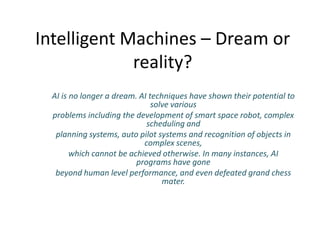
Introduction to AI
- 1. Intelligent Machines – Dream or reality? AI is no longer a dream. AI techniques have shown their potential to solve various problems including the development of smart space robot, complex scheduling and planning systems, auto pilot systems and recognition of objects in complex scenes, which cannot be achieved otherwise. In many instances, AI programs have gone beyond human level performance, and even defeated grand chess mater.
- 2. Influential areas for AI • „ Philosophy • „ Mathematics • „ Economics • „ Neuroscience • „ Psychology (1887-) • „ Computer engineering (1940-) • „ Control theory and Cybernetics (1984-) • „ Linguistics (1957-) • „ Education, Physics, Biology, etc.
- 3. comparison of features of brain and the modern computer Computer Human brain Computational units 1 CPU, 10^8 gates 10^11 neurons Storage units 10^10 bits RAM 10^11 Neurons 10^11 bits disk 10^11 Synapses Cycle time 10^-9 Second 10^-3 Second Bandwidth 10^10 bits/second 10^14 bits/second Memory updates/sec 10^9 10^14
- 4. Lesson 02- Foundation of AI • The Turing Test • Chinese room Argument • Four Schools of thought • History of AI • The state of the art
- 5. The Turing Test • The Turing Test, proposed by Alan Turing (195O), was designed to provide a satisfactory operational definition of intelligence.
- 6. The Turing Test • Acting humanly : The Turing Test approach • The computer would need to possess the following capabilities: (Limitation of the Turing Test) – natural language processing to enable it to communicate successfully in English – knowledge representation to store what it knows or hears – automated reasoning to use the stored information to answer questions and to draw new conclusions – machine learning to adapt to new circumstances and to detect and extrapolate patterns. (Total Turing Test) – computer vision to perceive objects, and – robotics to manipulate objects and move about.
- 7. The Turing Test • Obviously the standard Turing Test should be improved to accept various types of inputs, other than keyboard entries, to make the Turing test more usable. For example, we should be able to enter video signals as inputs to the Turing Test. An improved version of the Turing Test, known as Total Turing Test, needs Computer Vision and Robotic capabilities. • Problem : Turing test is not reproducible, constructive, or amenable to mathematical analysis
- 8. Chinese room argument • John Searle has presented yet another viewpoint known as Chinese room argument about machine intelligence • “a persons or an entity can be considered as intelligent, only if he performs a task being aware of it” • As such Searle claims that machines are not intelligent, because they are not conscious.
- 10. Four Schools of thought Systems that think like humans Systems that think rationally "The exciting new effort to make comput- "The study of mental faculties through ers think . . . machines with minds, in the the use of computational models." full and literal sense." (Haugeland, 1985) (Chamiak and McDermott, 1985) "[The automation of] activities that we "The study of the computations that make associate with human thinking, activities it possible to perceive, reason, and act." such as decision-making, problem solv- (Winston, 1992) ing, learning . . ." (Bellman, 1978) Systems that act like humans Systems that act rationally "The art of creating machines that per- "Computational Intelligence is the study form functions that require intelligence of the design of intelligent agents." (Poole when performed by people." (Kurzweil, et al., 1998) 1990) "A1 . . .is concerned with intelligent be- havior in artifacts." (Nilsson, 1998) "The study of how to make computers do things at which, at the moment, people are better." (Rich and Knight, 1991)
- 11. Acting humanly • AI attempts to develop machines that behave like humans. • This is exactly what the Turing Test claims as intelligent
- 12. Thinking humanly • Here AI attempts to develop machines that can think like humans • Problem solving, decision-making and learning
- 13. Thinking rationally • Thinking rationally stands for thinking logically. • However, it should be noted that all forms of knowledge in this world cannot be expressed in logic.
- 14. Acting rationally • the development of machines that do the right thing. • Ex:- assume that you ask a cup of tea from two home robots. When sugar is not available, one robot brings a cup of tea with a piece of sweet, while the other robot become silent as it cannot prepare a cup of tea due to lack of sugar. Obviously, we treat the first robot as the intelligent one.
- 15. History of AI •
- 16. The state of the art •
